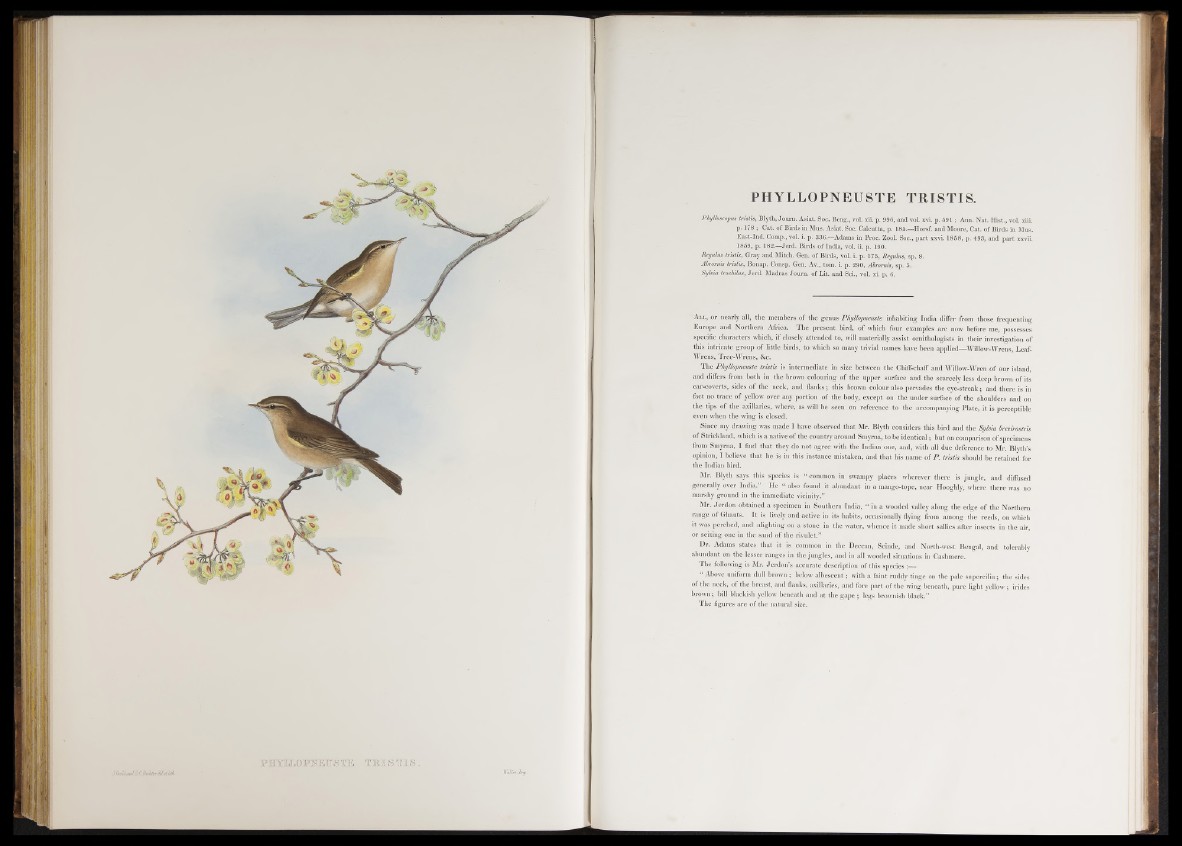
IPSraXOPKElITSTE IR IS T IS .
PHYLLOPNEUSTE TRISTIS.
Phylloscopus tristis, Blyth, Joum. Asiat. Soc. Beng., vol. xii. p. 996, and vol. xvi. p. 591 ; Ann. Nat. Hist., vol. xiii.
P-178 ; Cat. of Birds in Mus. Asiat. Soc. Calcutta, p. 185.—Horsf. and Moore, Cat. of Birds in Mus.
East-Ind. Comp., vol. i. p. 336.—Adams in Proc. Zool. Soc., part xxvi. 1858, p. 493, and part xxvii.
1859, p. 182.—Jerd. Birds of India, vol. ii. p. 190.
Regulus tristis, Gray and Mitch. Gen. of Birds, vol. i. p. 175, Regulus, sp. 8.
Abromis tristis, Bonap. Consp. Gen. Av., tom. i. p. 290, Äbromis, sp. 5.
Sylvia trochihs, Jerd. Madras Joum. of Lit. and Sei., vol. xi. p. 6.
All, or nearly all, the members of the genus Phyllopneuste inhabiting India differ from those frequenting
Europe and Northern Africa. The present bird, of which four examples are now before me, possesses
specific characters which, if closely attended to, will materially assist ornithologists in their investigation of
this intricate group of little birds, to which so many trivial names have been applied—Willow-Wrens, Leaf-
Wrens, Tree-Wrens, &c.
The Phyllopneuste tristis is intermediate in size between the Chiff-chaff and Willow-Wren of our island,
and differs from both in the brown colouring o f the upper surface and the scarcely less deep brown of its
ear-coverts, sides of the neck, and flanks; this brown colour also pervades the eye-streak; and there is in
fact no trace o f yellow over any portion o f the body, except on the under surface o f the shoulders and on
the tips of the axillaries, where, as will be seen on reference to the accompanying Plate, it is perceptible
even when the wing is closed.
Since my drawing was made I have observed that Mr. Blyth considers this bird and the Sylvia breoirostris
of Strickland, which is a native of the country around Smyrna, to be identical; but on comparison o f specimens
from Smyrna, I find that they do not agree with the Indian one, and, with all due deference to Mr. Blyth’s
opinion, I believe that he is in this instance mistaken, and that his name of P . tristis should be retained for
the Indian bird.
Mr. Blyth says this species is “ common in swampy places wherever there is jungle, and diffused
generally over India.” He “ also found it abundant in a mango-tope, near Hooghly, where there was no
marshy ground in the immediate vicinity.”
Mr. Jerdon obtained a specimen in Southern India, “ in a wooded valley along the edge o f the Northern
range of Ghauts. It is lively and active in its habits, occasionally flying from among the reeds, on which
it was perched, and alighting on a stone in the water, whence it made short sallies after insects in the air,
or seizing one in the sand of the rivulet.”
Dr. Adams states that it is common in the Deccan, Scinde, and North-west Bengal, and tolerably
abundant on the lesser ranges in the jungles, and in all wooded situations in Cashmere.
The following is Mr. Jerdon’s accurate description of this species :—
“ Above uniform dull brown ; below albescent; with a faint ruddy tinge on the pale supercilia; the sides
o f the neck, of the breast, and flanks, axillaries, and fore part o f the wing beneath, pure light yellow ; irides
brown; bill blackish yellow beneath and at the g a p e ; legs brownish black.”
The figures are o f the natural size.